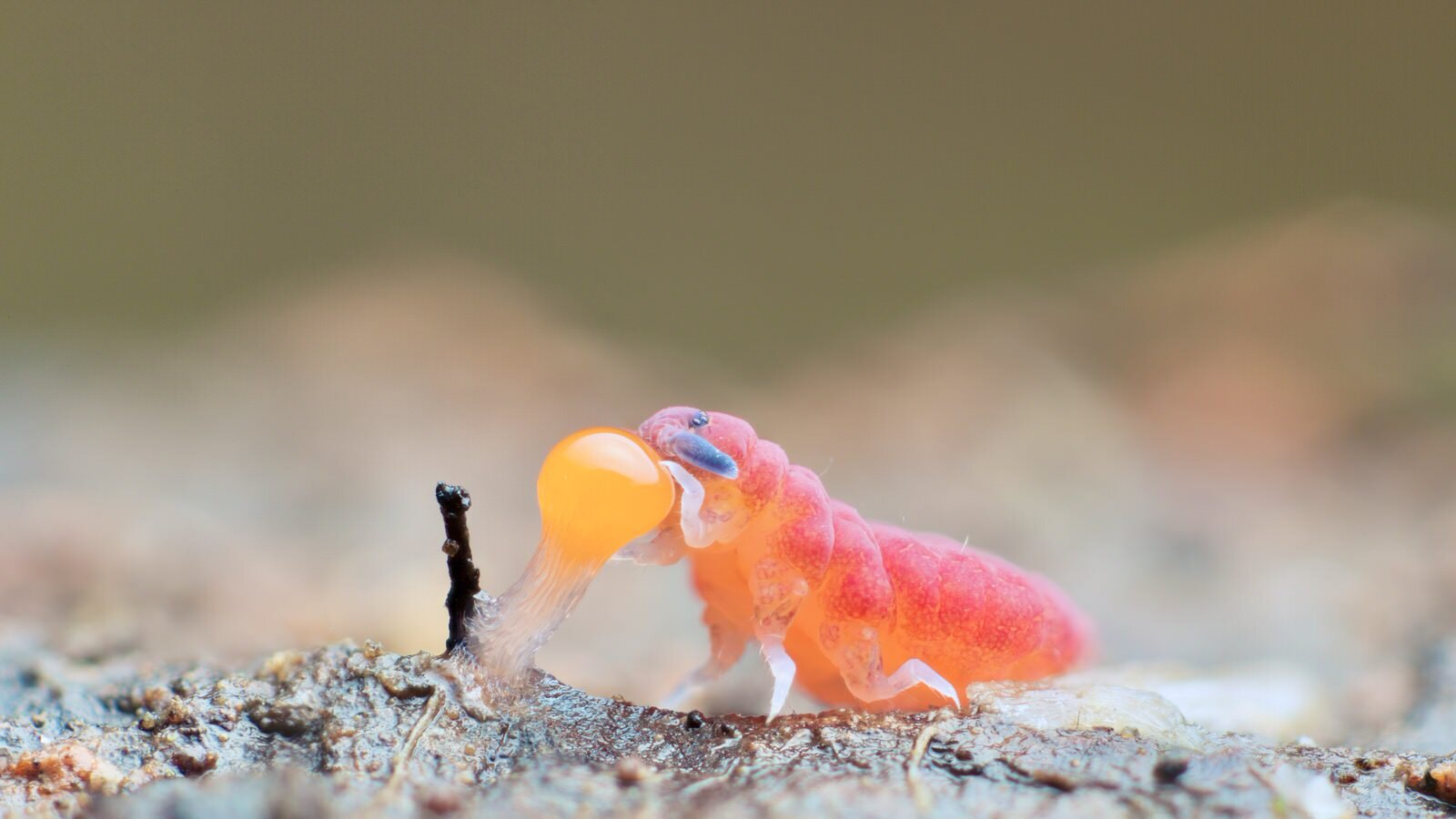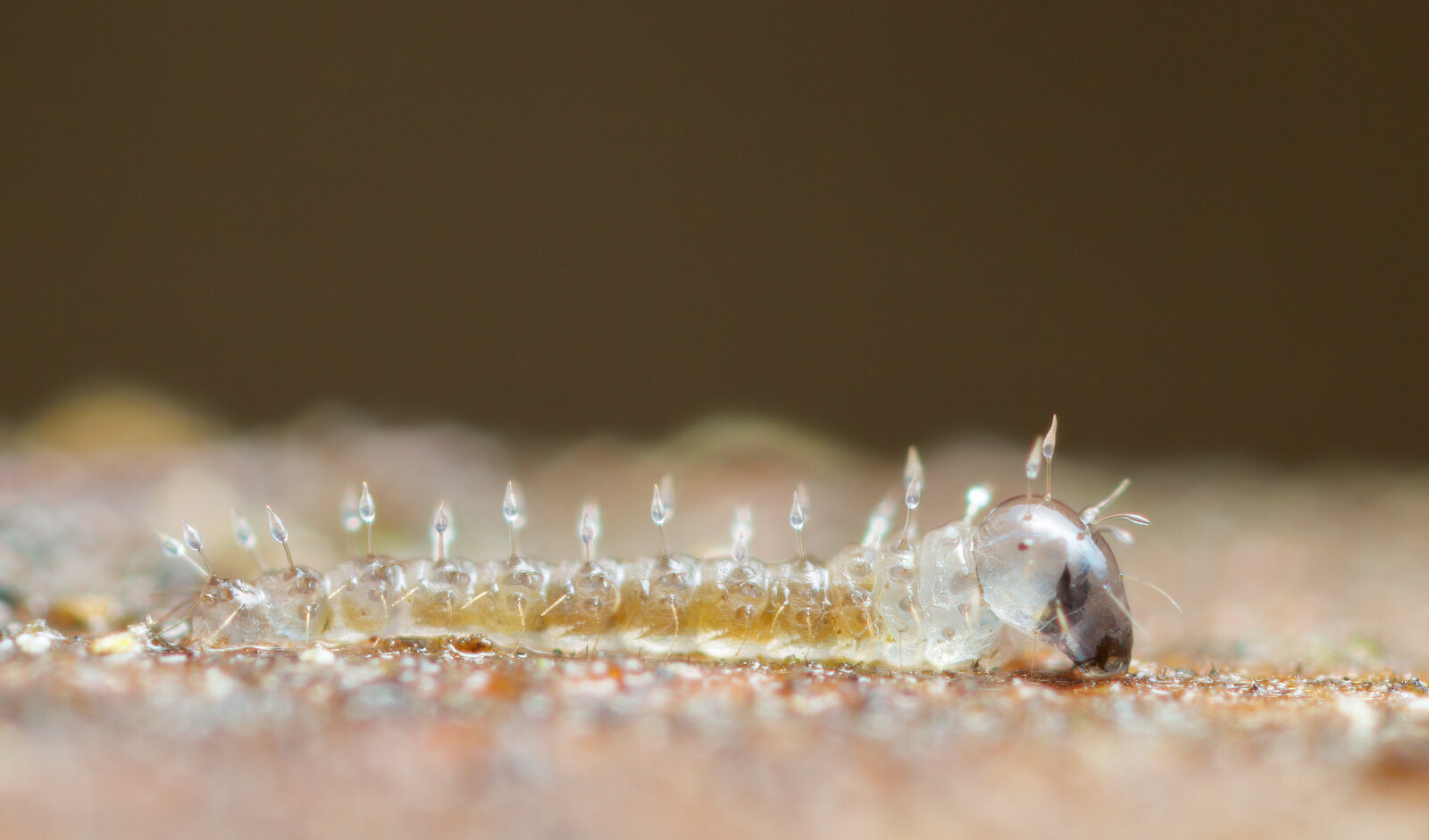
Soil animals-
springtails, soil mites and mesofauna
Soil mesofauna are very ancient and unusual soil animals, helping create the first soils nearly 500 million years ago, along with fungi and bacteria, well before flowers, trees and dinosaurs had even begun to be a twinkling in evolution’s eye. They have worked unceasingly ever since, and remain doing the same work in the present time, helping break down humic matter, minerals and bacteria into nutrients that plants can absorb.
In soil science, mesofauna are usually defined as invertebrates, sized between 0.1 mm and 2 mm, although some references increase this to 10 mm. Microfauna, such as protozoa and most nematodes inhabit the smaller world below 0.1 mm. They exhibit animal-like characteristics, and many are as yet undescribed. Macrofauna loosely defines anything bigger than 2 mm, from woodlice, worms, and ants to badgers and anyone digging a tunnel. If we want to talk about them all together, they’re usually known as soil fauna.
Soil mesofauna tend to lack colour. They are very often white or brown or translucent, eyeless and practically invisible to the naked eye, as they feel their way through pores and tiny gaps between soil particles, being too small to make their own holes. Mites and Collembola are often the gloriously colourful exceptions.
Bdellidae mite
Novokatianna species Collembola/springtail, NZ
“To see a World in a Grain of Sand And a Heaven in a Wild Flower…”.
Wise words from William Blake, and truly at the heart of my macro photography journey.
Although my first love will always be Collembola or springtails, the other mesofauna are just as interesting and unusual. Common members include mites, Symphyla, Diplura, Protura, nematodes, pauropods, the enchytraeids, a light scattering of pseudoscorpions, and midge and gnat larvae such as the Forcipomyiinae and Mycetophilidae.
Dicyrtomina minuta-Collembola/springtail, standing on snail eggs East Pennard March 2015
On this website, I’m attempting to be as inclusive and as wide ranging as I can in respect to the animals covered. While the ‘main’ and obvious soil animals are heavily featured- springtails, soil mites, pauropods, Diplura, Protura, nematodes, pseudoscorpions and Symphyla, the less well known animals are also covered. Hence the fact you will also be able to read about mite harvestmen, biting midge and fungus gnat larvae, ostracods, nemerteans, land planarians and the tiny micro snails. All contribute to the very small world of soil mesofauna, as well as all the many bacteria, fungi and myxomycetes that are only briefly mentioned in passing.
Here are links to some of those other areas to explore…
And some truly beautiful images by a hugely talented Myxomycete photographer, Barry Webb
A lovely article from Encyclopaedia Britannica about plant mycorrhiza
A great research article on plant mycorrhizal interactions and symbioses Root morphology and mycorrhizal symbioses together shape nutrient foraging strategies of temperate trees - Weile Chen et al 2016
As with most things in soil science, dividing soil animals into groups like micro, meso and macro are an easy though artificial way to roughly describe the complicated links and interactions between our most ancient collection of terrestrial arthropods. As my initial and ongoing interest in this tiny, wonderful world has been focused on Collembola, I'm including the full diversity of springtail sizes, not just the small, soil-dwelling mesofauna ones, as they're all incredible animals. I promise that all true mesofauna don't mind. I did try getting the giant Collembola into small wigs and mesofauna costumes but they weren't up for it.
Getting rid of soil mites and springtails
Online gardening and pest control websites often promote incorrect or misleading information, telling people how to get rid of those awful and evil soil bugs, demonising the very animals they should be encouraging to stay. It’s a long, slow and exasperating process of re-education but always worth the effort.
Soil mesofauna help in the breakdown of plant material and nutrient cycling, help remove pathogens, encourage mycorrhizal growth and are often important indicators of soil health, as well as being prey for many larger animals. They also contribute a lot of faecal matter to the soil, increasing fertility by making nutrients available for other organisms.
Cepheus dentatus- mite, Burrington Combe, February 2019
For a linked photographic key to the different classes and orders found in and around the soil, click the button below.
Acanthanura species,Collembola/springtail Lamington National Park, May 2016
What is soil and soil biodiversity?
Soil. It’s our greatest treasure.
It can take hundreds of years and many natural processes to make even a centimetre of soil. The mechanical and chemical weathering of rock makes up around half of any soil’s composition, with around 5% supplied by organic material, and the rest made up by air and water.
Put another way, soil is a complicated mix of both the non-organic, abiotic components- minerals, water and air, and the organic biotic components- bacteria, archaea, fungi, plants and invertebrates that live and die within it.
In addition, and bound together with any basic discussion about soil, is the reality of a living soil, the soil food web and soil biodiversity. Soil is a complex, sustainable and dynamic ecosystem, sustained through the complicated interaction of countless soil fauna like worms, woodlice, springtails, nematodes and mites, together with fungi and bacteria.
“Despite all our achievements, we owe our existence to a six-inch layer of topsoil and the fact that it rains.”
However, within a few generations, we have seen the world’s soils rapidly and increasingly degrade, losing nutrients, carbon and fertility, turning saline or actually blowing away. Crops are losing yield and not responding to NPK fertilisers. Fields and farms are being abandoned across much of the world, forcing even more poverty, suffering and human migration. This degrading is mostly human-driven, due to bad farming practices, pollution, acidification, compaction, deforestation and climate change across the world. It’s a sobering and worrying time. Soil biodiversity is dying, with soil fauna like springtails and soil mites reducing to almost zero. Worms are disappearing, fungal activity ceasing.
Soil scientists and farmers are finally being listened to by the EU, the United Nations and most global governments. Research is now well funded and positive changes are being discussed at a governmental level and implemented on a regional and local level. Sustaining, improving and increasing soils is a lengthy and time consuming process, but no dig and regenerative agriculture for example are showing great results. Feeding the soil rather than the plant has become a well known mantra amongst gardeners and organic growers. The ship may be sinking, but all is not lost.
I fully recommend researching more on the subject, especially through resources like the Global Soil Biodiversity Initiative.
And of course, the Food and Agriculture Organisation of the United Nations’ Soils Portal
This is a good overview of soils from the British Society of Soil Science- What Are Soils
Or this rather beautifully written paper showing why we should care- Biodiversity across trophic levels drives multifunctionality in highly diverse forests -Andreas Schuldt, Thorsten Assmann and Helge Bruelheide 2018”
“Whoever you are and whoever you will become, tread lightly on the earth.”
A ridiculously sweet Forcipomyia larva
A Chaos of Delight
‘A Chaos of Delight’ is a website born out of my deep and abiding love for some very small and beautiful soil animals known as soil mesofauna, as mentioned above.
The website’s name derives from a famous passage taken from the journals of Charles Darwin, where he describes visiting a Brazilian rainforest.
“The delight one experiences in such times bewilders the mind, — if the eye attempts to follow the flight of a gaudy butter-fly, it is arrested by some strange tree or fruit; if watching an insect one forgets it in the stranger flower it is crawling over, — if turning to admire the splendour of the scenery, the individual character of the foreground fixes the attention. The mind is a chaos of delight out of which a world of future & more quiet pleasure will arise.”
I find Darwin’s passion, excitement and existential joy when writing about the natural world to be deeply moving and inspiring.
For me, the passage relates to and describes my own experience over the years of studying, photographing and writing about Collembola and the other soil mesofauna. It’s an incredibly rich, diverse world down there amongst the leaf litter, the rotten logs and soil, as jaw-dropping and awe-filled for me as Darwin’s ecstatic rainforest experience.
It’s a slightly obscure name for a soil animal website, and I stand by it.
A eurypauropod, UK
Footnote
This website was set up to have as complete an overview of soil mesofauna as possible, within the limits of what I find funny. The information contained within is as up to date as possible.
The photographs are all ©Andy Murray, apart from four...
I have many thousands of photos not on my website for sale as hi-res copies for personal collections, exhibitions, books and articles.
I am available for custom macro and micro photography work and projects around soil animals and soil biodiversity, writing and editing work, as well as general Collembola and mesofauna info and consultation.
Just contact me here or through the contact button at the top of the page.
Thanks to all the people that have helped me in so many ways to pursue my passion for photography and the micro world, as well as generously offering me an education in their own fields of expertise. Their help with understanding many of the beautiful mesofauna described on this website and kindly correcting my many mistakes are also gratefully acknowledged.
My latest blog posts on soil mesofauna
Below are the latest images from my Instagram page- @soilanimals















Soil is the last truly unexplored region of the planet, and it lies right below our feet. in celebration of the theme of World Soil Day 2025, I thought I would write a short blog post showing some of the remarkable and beautiful tiny soil animals that can be found surviving and sometimes thriving in an urban environment.
I often get asked about how to take decent photos of springtails and all the other tiny mesofauna. So here is a general breakdown of what I’ve learned, the mistakes I’ve made, and the tricks and techniques that I use that will improve your extreme macro photos.
Soil mites are supposed to an annoying pest in our plant pots and gardens, and present a risk to human health. But are we just being lied to by gardening and pest control companies for profit?